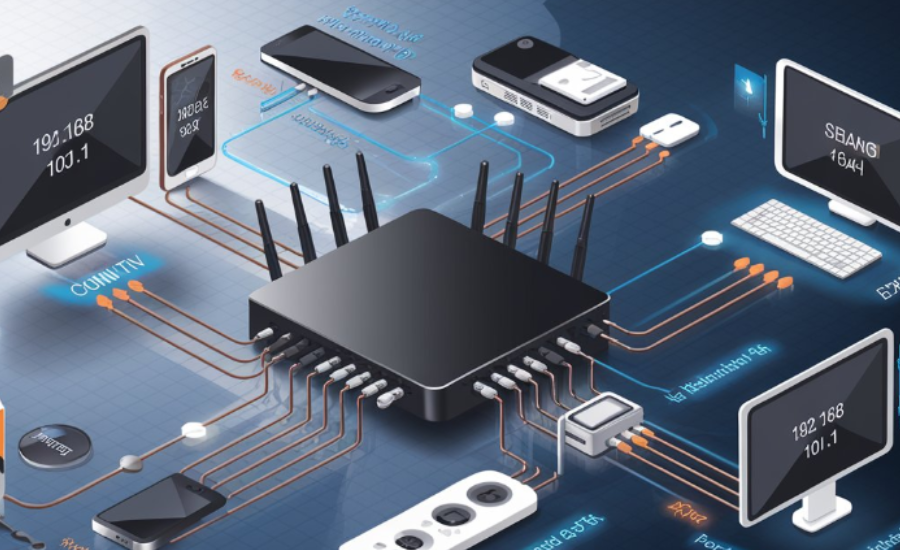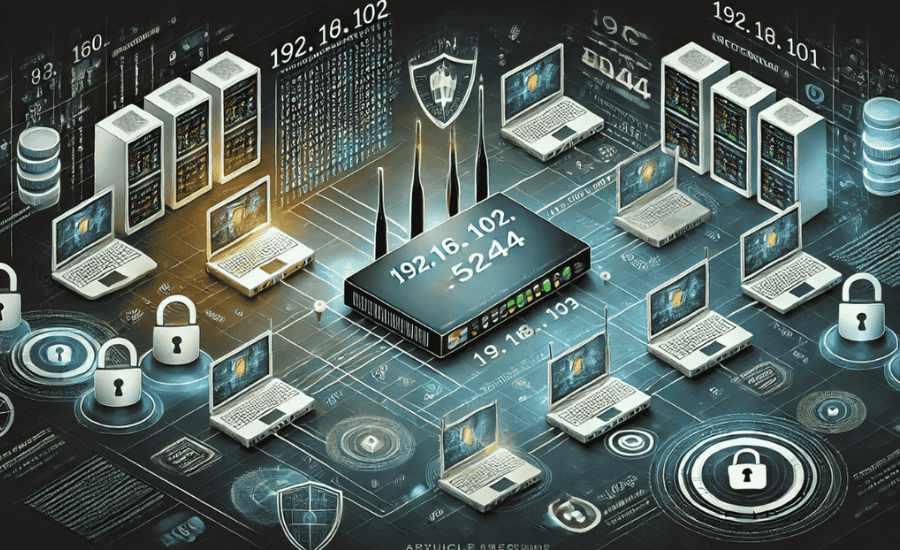In today’s digital landscape, grasping the functionality of IP addresses and network ports is crucial for effective network management, whether for personal or business use. The address 192. 168. 101. 23:5244 serves as a prime example of a private network address coupled with a designated port number. This combination plays a significant role in establishing secure and efficient connections within local networks. This overview will delve into the intricacies of 192. 168. 101. 23:5244, outlining its operational principles and the reasons it is frequently utilized in private settings. Additionally, we will discuss the types of devices that typically connect to this address and provide insights on common troubleshooting techniques.
Accessing the IP address 192. 168. 101. 23:5244 can vary depending on the devices in use and the specific networking setup in place. This address is often associated with local network devices, such as routers, printers, and other smart devices that require a unique identifier for proper communication. Understanding how to navigate to this IP address is essential for users seeking to resolve connectivity issues or configure their devices effectively. By following best practices for network management and troubleshooting, users can ensure a seamless experience while maximizing their network’s performance and reliability.
Understanding Private IP Addresses: A Focus on 192. 168. 101. 23:5244

The private IP address 192. 168. 101. 23:5244 is commonly employed in local network configurations, such as those found in home Wi-Fi systems and corporate LANs (Local Area Networks). This address belongs to the 192.168.x.x series, which has been designated for private usage by the Internet Assigned Numbers Authority (IANA). Such IP addresses cannot be accessed directly from the internet, as they do not have the capability to be routed in public IP networks. Instead, they serve an essential function in identifying devices within a localized environment, facilitating communication between computers, smartphones, and various IoT devices operating within that network.
At the end of the IP address, the number 5244 denotes a port number that specifies a particular service or application running on the device associated with 192. 168. 101. 23:5244. This port designation allows multiple services to operate simultaneously over a single network connection without causing conflicts. By using port numbers, devices can manage different types of traffic effectively, ensuring that applications such as web servers, file transfers, and other services function correctly. Thus, port 5244 plays a vital role in directing network requests to the appropriate application on the designated device.
Understanding the intricacies of 192. 168. 101. 23:5244 is crucial for anyone managing a network, as it enables better troubleshooting and configuration of connected devices. Knowing how to navigate to this IP address can help users resolve connectivity issues, set up new devices, and optimize network performance. Moreover, awareness of the specific services associated with port 5244 can enhance the user experience by ensuring that applications run smoothly and efficiently. By familiarizing oneself with these concepts, users can take full advantage of their network capabilities and maintain seamless communication across all connected devices.
Understanding the Functionality of 192. 168. 101. 23:5244
To grasp how the address 192. 168. 101. 23:5244 operates, it is essential to dissect both the private IP address and the associated port number. The IP address 192.168.101.23 belongs to a range designated for private use, commonly found in residential and small business networks. Within these environments, devices can communicate seamlessly with one another using such private IP addresses. However, direct access to these addresses from outside the network is typically restricted unless specific configurations, like port forwarding or the use of a VPN, are implemented. This design helps to maintain security and control over the local network.
The Significance of Port Number 5244
In the realm of networking, every IP address is capable of supporting up to 65,535 distinct ports. Each port number corresponds to specific services or protocols, facilitating various types of communication. For instance, while port 80 is generally reserved for HTTP traffic, port 5244 may be assigned to a proprietary service or a specialized application on a device connected to the network. Therefore, the combination of 192.168.101.23 and port 5244 allows users or systems to pinpoint and access a particular service operating on that specific IP address within the local network.
Accessing Services via 192. 168. 101. 23:5244
When a user attempts to connect to 192. 168. 101. 23:5244, they are essentially trying to reach a specific device identified by the private IP address and, more importantly, to engage with a service or application actively listening on port 5244. This process is crucial for various tasks, such as accessing shared files, utilizing networked applications, or managing device settings. Understanding this functionality can empower users to troubleshoot network issues, configure devices correctly, and enhance their overall networking experience within their private network.
The Importance of Private IP Addresses

Private IP addresses, such as 192.168.101.23, enable numerous devices to coexist within the same local network without any conflict. These private IP ranges are critical for fostering efficient and secure network operations, particularly in residential and business environments. By allowing multiple devices to connect without overlapping identifiers, these addresses ensure that local network communication remains organized. This setup not only optimizes connectivity but also contributes to the overall security and integrity of the network, making it an essential component for effective network management.
Understanding IP Addresses and Their Role
An IP address serves as a unique identifier for every device connected to a network. The address 192. 168. 101. 23:5244 is classified as a private IP address, which places it within the 192.168.x.x range reserved specifically for internal networking. The primary purpose of these private addresses is to facilitate seamless communication among devices within a local network while preventing interference with the public internet. Routers are instrumental in this process, as they translate these private IP addresses into public ones, allowing devices to access the internet when necessary. This translation maintains the privacy of internal communications while enabling external connectivity.
Distinguishing Between Private and Public IP Addresses
Private IP addresses like 192. 168. 101. 23:5244 are inherently inaccessible from the broader internet, serving solely to identify devices within a confined local network. In contrast, public IP addresses are unique on a global scale and facilitate communication between different networks across the internet. The use of private IP addresses is particularly advantageous for home and office setups, as it conserves the finite number of available public IP addresses and adds an extra layer of security by keeping internal devices shielded from outside access. This isolation helps safeguard sensitive data and minimizes vulnerabilities to external threats.
Exploring Port 5244 and Its Applications
In networking terminology, a port acts as a virtual gateway that directs network traffic to the appropriate service or application operating on a device. While ports like 80 and 443 are commonly associated with web traffic, port 5244 may be linked to specific services or applications on devices within a local network. This could include servers, IP cameras, or even gaming consoles that require distinct communication channels. When configured correctly, port 5244 can facilitate seamless interaction between devices on the network or enable communication with external systems via port forwarding. Understanding the role of this port in conjunction with the IP address 192. 168. 101. 23:5244 is crucial for users seeking to optimize their network performance and configuration.
IP Address 192.168.101.23:5244 and Its Role in Network Devices

The IP address 192. 168. 101. 23:5244 is commonly linked with devices that require communication over specific network ports within a home or business network. This combination of a private IP address and port number allows for efficient traffic routing and device management, enabling various services to operate without conflict. Devices like routers, servers, and IoT gadgets rely on such configurations to maintain seamless communication within the local network and, in some cases, with external systems.
Routers and the Assignment of 192.168.101.23:5244
Routers are critical in managing network devices, often assigning private IP addresses like 192. 168. 101. 23:5244 to various connected devices. The router itself could also use this IP and port for administrative purposes, allowing network managers to access its settings and configurations. By leveraging the combination of IP address and port number, routers help to streamline communication between connected devices and ensure the smooth operation of services like file sharing, internet access, and more.
Servers and Their Use of 192.168.101.23:5244
Servers operating within a local network may also be assigned the address 192.168.101.23:5244 for internal communication or to allow access from external devices through port forwarding. For instance, web servers or file servers can use this configuration to serve data and applications to devices within the same network or to authorized external users. By configuring the router to forward traffic to this specific IP and port, administrators can manage secure access to sensitive files and applications housed on the server.
IoT Devices and Network Communication
With the rise of smart homes and businesses, IoT devices such as smart lights, cameras, and security systems often rely on custom IP addresses like 192.168.101.23 and specific ports such as 5244. These devices require dedicated communication pathways for their unique functions, whether it’s streaming video, sending alerts, or adjusting settings remotely. By assigning unique IP and port combinations, IoT devices can avoid interference from other devices and ensure that their commands and data transmissions are processed efficiently within the network.
Computers and Consoles Utilizing 192. 168. 101. 23:5244
In addition to routers and IoT devices, personal computers and gaming consoles may also utilize the IP address 192. 168. 101. 23:5244 for specific services. These devices often need dedicated ports to handle tasks like file sharing, game streaming, or multiplayer gaming sessions. The port number 5244 can be configured to facilitate these operations, ensuring smooth performance and uninterrupted service. By assigning specific IPs and ports to these devices, network administrators can optimize their functionality while maintaining network security and efficiency.
Connecting to 192. 168. 101. 23:5244: A Step-by-Step Guide
To access 192.168.101.23:5244, you need to be connected to the same local network as the device using this IP address. This connection is essential, as 192.168.x.x IP addresses are designed for private networks and are not accessible from outside without proper configurations. Whether you’re using a PC, smartphone, or tablet, ensuring network alignment is the first step. The IP address is most commonly used in home Wi-Fi systems or business LANs, allowing devices to communicate seamlessly. Without this network connection, attempts to access the service via 192. 168. 101. 23:5244 will fail.
Using a Web Browser for Access
In most cases, local devices configured with a custom IP address and port, such as 192. 168. 101. 23:5244, can be accessed through a standard web browser. To proceed, simply open your preferred browser and type http://192.168.101.23:5244 into the address bar. Depending on the device and its configuration, this may direct you to a user interface or a specific application page. For example, it could be the configuration interface for a router or a custom dashboard for an IoT device. The simplicity of accessing devices via a web browser streamlines management and troubleshooting tasks.
Logging into the Device
When accessing a secured device like a router or another networked device using the IP address 192. 168. 101. 23:5244, you might be prompted to log in with a username and password. These credentials are often set by default by the manufacturer and can be found in the device’s manual or packaging. However, for security reasons, it is recommended that users change these default credentials after the initial setup. Logging in allows you to manage the device’s settings, view its status, and troubleshoot issues directly from the user interface.
Configuring Port Forwarding for Remote Access
If you need to access 192. 168. 101. 23:5244 from outside the local network, setting up port forwarding on your router is essential. Port forwarding allows external devices to connect to services hosted within your private network by mapping a specific external port to the internal IP address and port combination, in this case, 192. 168. 101. 23:5244. This configuration opens up remote access, enabling you to manage or use the device’s services even when you’re not on the same local network, but always ensure to secure your network to prevent unauthorized access.
Final Considerations for Network Access
Before attempting to access 192. 168. 101. 23:5244, verify that the device you’re trying to reach is active and properly configured to accept connections. Double-check the IP address and port number to ensure they are correct and that no firewalls or security software are blocking your access. Maintaining secure credentials and enabling encrypted connections, where possible, are essential steps to protecting your network from vulnerabilities. Understanding how to navigate these configurations will give you greater control over your devices and allow for smooth, uninterrupted network management.
Troubleshooting Common Issues with 192. 168. 101. 23:5244

Using IP addresses like 192.168.101.23 and ports such as 5244 within a private network can sometimes lead to connectivity issues if the setup is not properly configured. Several factors could prevent seamless access to devices assigned to this IP and port combination, and troubleshooting these issues is crucial for maintaining smooth network operations. Whether it’s a connection issue, firewall settings, or port forwarding problems, identifying the root cause is the first step in resolving the issue.
Connection Problems: Addressing the Basics
One of the most common reasons for being unable to access 192. 168. 101. 23:5244 is a connection issue. If you’re not on the same local network as the device you’re trying to connect to, this IP address will not be reachable. Make sure your device, whether it’s a computer, smartphone, or another networked gadget, is connected to the same home or business network. Additionally, check that the device assigned to 192.168.101.23 is powered on and properly connected to the network. A simple reboot or reconnection may fix the issue. Lastly, confirm that no firewall settings are blocking access to this IP address or port. Firewalls often restrict access to protect network security, so ensuring the right permissions are in place can resolve this problem.
Port Forwarding Issues for Remote Access
If you’re trying to access 192. 168. 101. 23:5244 from outside the local network, configuring port forwarding on your router is necessary. Port forwarding allows external devices to connect to a local network through a public IP address. If this feature is not set up properly, you may encounter access issues. Start by checking your router’s settings to verify that port 5244 is correctly forwarded to the internal IP address 192.168.101.23. Also, double-check that you’re using the correct public IP address when attempting to access the service remotely. Any mismatch in these configurations can prevent successful connection attempts from external networks.
Resolving Router Configuration Errors
Incorrect router settings can also block access to 192. 168. 101. 23:5244. In some cases, the router’s DHCP settings might not have assigned the correct IP address to the intended device. To resolve this, check your router’s DHCP settings and make sure the device is receiving the correct IP address. If problems persist, consider resetting the router to its factory settings and reconfiguring the network from scratch. A reset can often resolve configuration errors that are difficult to pinpoint and provide a fresh start for setting up the network correctly.
Verifying Device Status and Network Connectivity
In some cases, the issue might not lie with the router or firewall but with the device itself. Ensure that the device assigned to 192.168.101.23 is online and functioning correctly. If the device is offline or experiencing technical difficulties, it won’t be accessible via 192. 168. 101. 23:5244. You can troubleshoot the device by restarting it, ensuring that it is properly connected to the network, and checking for any internal errors that might be preventing it from functioning normally.
Checking Network Permissions and Firewall Settings
Firewalls and network permissions are designed to block unauthorized access, but sometimes they can interfere with legitimate connections. If you’re having trouble connecting to 192. 168. 101. 23:5244, check your firewall settings to ensure that the necessary permissions are in place. You may need to create a rule allowing access to both the IP address and port in question. Additionally, some routers come with built-in firewalls that may need to be adjusted. Ensuring these settings are correct will help establish a stable connection to the device.
Diagnosing Port Conflicts
Another potential issue could be port conflicts within the network. While port 5244 may be assigned to a specific device, other devices on the network might attempt to use the same port, leading to communication issues. To avoid this, ensure that no other devices are assigned to the same port on the network. You can resolve this conflict by changing the port number for one of the devices or ensuring unique IP-port combinations for each connected device.
Resetting and Reconfiguring Network Settings
If you’ve tried all the above troubleshooting steps and still cannot connect to 192. 168. 101. 23:5244, resetting your router and network settings might be the best course of action. Start by resetting the router to its factory settings, which will clear any misconfigurations. Then, set up the network again, ensuring that the IP address and port configurations are correctly assigned. Reconfiguring from scratch can resolve lingering issues and provide a fresh start for the network.
Ensuring Proper Device Configuration
It’s essential to verify that the device using 192. 168. 101. 23:5244 is correctly configured for the network. This includes checking the device’s internal settings for IP address assignment and port usage. Some devices might require manual configuration to ensure they are using the correct IP and port, so ensure that these details are correctly entered. If the device allows it, enabling dynamic IP assignment through DHCP can simplify future troubleshooting by ensuring the device always has the correct address.
Final Steps for Maintaining Network Health
Maintaining a healthy network involves regularly checking device configurations, ensuring firewall settings are updated, and verifying that port forwarding rules are functioning correctly. By regularly auditing your network, including IP addresses like 192.168.101.23 and ports like 5244, you can prevent future issues and ensure your devices remain accessible both locally and remotely. Taking these steps will help keep your network running smoothly and securely.
FAQs
Q1. What is 192. 168. 101. 23:5244?
A. It is a private IP address combined with port number 5244, typically used for communication within local networks, like home Wi-Fi systems or corporate LANs.
Q2. What devices use 192.168.101.23:5244?
A. Devices such as routers, IoT devices (e.g., cameras, smart lights), servers, and gaming consoles may use this IP and port combination for specific services or functions.
Q3. Can I access 192.168.101.23:5244 from the internet?
A. No, private IP addresses like 192.168.101.23 cannot be accessed directly from the internet unless port forwarding or a VPN is configured.
Q4. What is port 5244 used for?
A. Port 5244 may be assigned to a specific service or application running on the device, allowing multiple services to operate without conflicts on the same network.
Q5. How do I access 192.168.101.23:5244?
A. You can access it via a web browser by entering the address (http://192.168.101.23:5244) while connected to the same local network.
Related: 21153-7010-16121-Starter-Rebuild-Kit
Conclusion
In conclusion, the IP address 192.168.101.23:5244 is a crucial component in local network communication, providing a unique identifier for devices and facilitating specific services through port 5244. Understanding how this combination functions within private networks is essential for effective device management, troubleshooting, and ensuring seamless connectivity. Proper configuration and maintenance of network settings, including port forwarding and firewall adjustments, are key to optimizing performance and maintaining secure and efficient communication between devices.
Stay connected for the latest news and exciting stories on America News!





